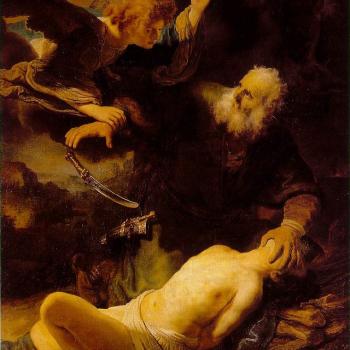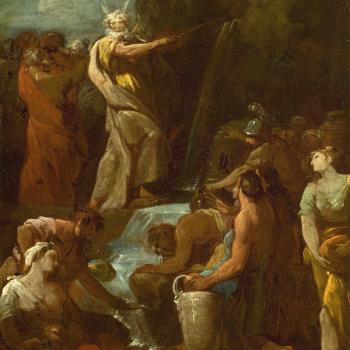1 Samuel 27:1-3, 5-7 (RSV) And David said in his heart, “I shall now perish one day by the hand of Saul; there is nothing better for me than that I should escape to the land of the Philistines; then Saul will despair of seeking me any longer within the borders of Israel, and I shall escape out of his hand.” So David arose and went over, he and the six hundred men who were with him, to Achish the son of Maoch, king of Gath. And David dwelt with Achish at Gath, . . . Then David said to Achish, “If I have found favor in your eyes, let a place be given me in one of the country towns, that I may dwell there; for why should your servant dwell in the royal city with you?” So that day Achish gave him Ziklag; therefore Ziklag has belonged to the kings of Judah to this day. And the number of the days that David dwelt in the country of the Philistines was a year and four months.
1 Samuel 30:1, 3 Now when David and his men came to Ziklag on the third day, the Amalekites had made a raid upon the Negeb and upon Ziklag. They had overcome Ziklag, and burned it with fire, . . . And when David and his men came to the city, they found it burned with fire, . . .
An article in Israel Today: Archaeology, “Have Archeologists Found the Biblical City of Ziklag?,” by Tsvi Sadan (7-10-19) summarizes the recent discovery:
After four years of excavations, Israeli archaeologists Yosef Garfinkel of the Hebrew University and Saar Ganor of the Israel Antiquities Authority, along with Australian archaeologist Kyle Keimer of Sidney’s MacQuarie University, announced on Monday that Khirbet a-Ra’i, located between the modern city of Kiryat Gat and Lachish, is most likely the Philistine city of Ziklag, where David found refuge from king Saul (1 Sam. 27). . . .
Khirbet a-Ra’i yields both Philistine and Judean artifacts, which means that this site was both a Philistine and Judean city. That fits the biblical account, which says that this Philistine city was given to David, . . .
Other reasons for designating the site as Ziklag are the Philistine artifacts themselves, dated to the 12th-11th centuries BC, . . . Similar artifacts have been found in the Philistine cities of Ashdod, Ashkelon, Ekron and Gat[h]. . . .
Above the Philistine remains were found the remains of an agricultural settlement from the time of King David. Some of the nearly 100 intact clay vessels found at the site are identical to those found in Khirbet Qeiyafa, the biblical She’arayim. . . .
Furthering the claim that this is Ziklag is the clear evidence of a massive fire, which could confirm the biblical account of the Amalekites burning the city . . .
Yosef Garfinkel elaborates:
Twelve different suggestions to identify Ziklag have been put forward, such as Tel Halif near Kibbutz Lahav, Tel Sera in the Western Negev, Tel Sheva, and others. However, none of these sites produced continuous settlement which included both a Philistine settlement and a settlement from the era of King David. (in Enrico de Lazaro, “Archaeologists Locate Long-Lost Biblical City of Ziklag,” Science News, 7-25-19)
See a map of Ziklag’s location in Israel.
Yosef Garfinkel and Saar Ganor provide further confirming details:
If . . . we take into account the currently agreed location of Gath at Tell es-Safi, Ziklag should be located in a much more northerly location, . . .
Ziklag is presented as a rather remote place in relation to the capital city of Gath. Hence, it should probably be located at the edge of the territory of Gath. Spatial analysis of the Philistine settlement pattern has indicated that these cities controlled an area of about half a day’s walk form the major city(Garfinkel 2007). Hence, Ziklag should be at a distance of no more than c. 15 km from Gath. Scholars who place Ziklag 30 or 40 km away from Gath do not present a realistic estimation of the territory of a Philistine city-state. . . .
Although it seems likely that only epigraphic finds can confirm the identification of the site with Ziklag, in the current state of knowledge Khirbet al-Ra‘i is a much better candidate then any of the previous suggestions. The location of Khirbet Qeiyafa and Khirbet al-Ra‘i in similar geopolitical positions signifies the same strategic viewpoint. Khirbet al-Ra‘i sits on the border between Judah and Philistia on the western edge of the Shephelah and opposite the Philistine city of Ashkelon, controlling the road running through the Lachish Valley. Likewise, Khirbet Qeiyafa sits on the same border opposite the Philistine city of Gath (Tell es-Safi) and controls the road running through the Elah Valley. In the very late 11th and early 10th century BCE under King David, Judah was a small territory in Jerusalem and the hill country, with the border of the western Shephelah region being marked by Khirbet Qeiyafa and Khirbet al-Ra‘i. Even David’s lament for Saul and Jonathan (‘Tell it not in Gath, publish it not in the streets of Ashkelon’; 1 Sam 1:20) receives new meaning, as Khirbet Qeiyafa is located opposite Gath and Khirbet al-Ra‘i is located opposite Ashkelon. In this context, identifying Ziklag at Khirbet al-Ra‘i explains why it is mentioned extensively in the biblical traditions of King David. (“Was Khirbet al-Ra‘i Ancient Ziklag?,” Strata: Bulletin of the Anglo-Israeli Archaeological Society 2019, vol. 37: 51–59)
***
Practical Matters: Perhaps some of my 4,200+ free online articles (the most comprehensive “one-stop” Catholic apologetics site) or fifty-one books have helped you (by God’s grace) to decide to become Catholic or to return to the Church, or better understand some doctrines and why we believe them.
Or you may believe my work is worthy to support for the purpose of apologetics and evangelism in general. If so, please seriously consider a much-needed financial contribution. I’m always in need of more funds: especially monthly support. “The laborer is worthy of his wages” (1 Tim 5:18, NKJV). 1 December 2021 was my 20th anniversary as a full-time Catholic apologist, and February 2022 marked the 25th anniversary of my blog.
PayPal donations are the easiest: just send to my email address: apologistdave@gmail.com. You’ll see the term “Catholic Used Book Service”, which is my old side-business. To learn about the different methods of contributing, including 100% tax deduction, etc., see my page: About Catholic Apologist Dave Armstrong / Donation Information. Thanks a million from the bottom of my heart!
***
Photo credit: David before Saul (1640s), by Jusepe Leonardo (1601-?) [public domain / Wikimedia Commons]
***
Summary: Archaeologists are convinced that the city of Ziklag, where David hid from King Saul for sixteen months, has been identified: in harmony with the biblical data.


















